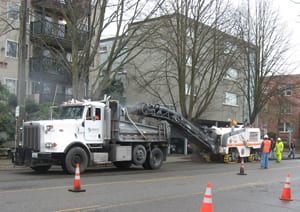 SDOT crews resurface a block of California Avenue SW.
SDOT crews resurface a block of California Avenue SW. You may be familiar with SDOT’s Pothole Rangers, but there is another group of SDOT employees that is maintaining streets—they are SDOT’s own paving crews. When a pot of money—$ 2.7 million—became available last year from the sale of SDOT’s rubble yard, they put it to very good use by efficiently targeting small parts of arterial streets that are in very bad condition.
There are certain smaller areas of pavement around the city that are damaged so severely that they are a constant bother to everyone. A pothole repair in one of these areas is short lived because there is very little surrounding pavement to keep the patch in place. The pothole repair crews spend much of their time revisiting these areas, trying to mend them as best they can. By paving some of these streets, and providing a new, smooth surface that is no longer are plagued with potholes, the time of the pothole crews is freed up. The pothole crews can then spend their time more effectively by working on streets where pothole repairs will last longer.
SDOT’s annual paving program includes large projects that are bid out to contractors as well as smaller projects that are performed by SDOT crews. SDOT’s annual arterial street paving program is mostly funded by the Bridging the Gap transportation initiative approved by Seattle voters. Due to the economic downturn, other funding available for street paving is greatly diminished, while street maintenance needs continue to accumulate. Paving work done with part of the proceeds of the rubble yard sale—$3.3 million over the next two years—is an addition to their other work.

At the beginning of each day, crews set up the street to safely channel traffic around the work area.
Street maintenance managers have been carefully selecting the spots for this additional work. Following the state requirement for competitive bidding for larger jobs, SDOT’s crews limit their work to smaller, less expensive projects. They look for small areas where a simple resurfacing job will solve the pothole problem and spots that do not require drainage improvements, extensive base repairs, or other costly complications. They work on streets that are not otherwise scheduled for paving for many years, and they try to distribute their work equitably around the city.
When street paving crews were asked to perform the extra work with the rubble yard sale proceeds last year, they set out to show how good of a job they could do on all of their paving work. Starting mid-year, when the additional funds first became available, the crews followed a grueling schedule. During the summer and early fall they worked 10+ hours a day, four days a week, instead of the usual eight-hour, five-day work week. With this schedule, they were able to reduce the time required for setting up equipment and traffic controls. Jobs in the same vicinity were done at the same time, allowing a quick transition from one job to the next. The crews continued paving through December, compared to previous years when their paving season ended early in the fall.
By the end of the year, with the extra funding added to the usual annual paving funds, the crews had paved almost 16 lane miles (a lane mile is the area equivalent to a single lane of pavement across one mile) at approximately 86 locations, compared to the previous typical three and a half lane miles a year.
This year, with the remaining funds allocated to them from the rubble yard sale, the crews are continuing this expanded work load, paving many troublesome street locations. Everyone who uses the streets–drivers, bicyclists and pedestrians, will benefit from the smoother surfaces.
Note: To report a pothole or to request another type of minor street surface repair, use the online form, or call (206) 684-ROAD.
